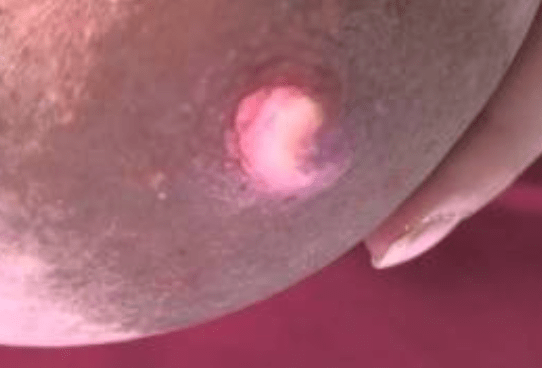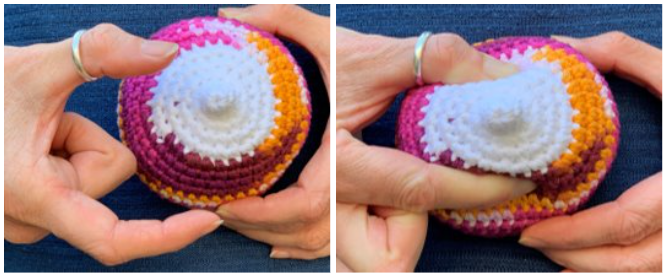What Is Vasospasm/Raynaud’s of the Nipple?
Vasospasm refers to the sudden constriction of blood vessels, limiting blood flow to a specific area. In breastfeeding, this typically affects the nipples. When exposed to cold or stress, the blood vessels in the nipple tighten, causing intense pain, blanching, or a change in colour—from white to blue to red—as blood flow returns. Raynaud’s is more commonly known for affecting the hands and feet, but in breastfeeding mothers, it can also occur in the nipples, leading to discomfort during and after feeding (Cocoman & Delaney, 2022).
Recognising the Symptoms
The symptoms of nipple vasospasm are distinct:
- Severe, shooting pain in the nipple or breast during or after feeding
- Colour changes in the nipple (white, blue, or red) after feeding
- Burning sensation or tingling in the nipple
- Cold sensitivity in the breasts or nipples
These symptoms can be mistaken for other breastfeeding issues like thrush, but it’s crucial to differentiate vasospasm to ensure the correct treatment approach. Unlike infections, vasospasm typically occurs in response to cold, stress, or improper latch (Fetherston & Harrison, 2021).


What Causes Vasospasm?
Several factors may trigger or worsen vasospasm during breastfeeding:
- Cold exposure: Cold air, drafts, or cold weather can lead to vasospasm.
- Stress and anxiety: Emotional stress can contribute to episodes of vasospasm.
- Poor latch or shallow attachment: If a baby is not latching deeply, it can cause damage to the nipples, triggering vasospasm.
- Previous history of Raynaud’s: Women who have experienced Raynaud’s in other areas, such as the hands or feet, may be more prone to developing it in the nipples.
The Impact on Breastfeeding
For many mothers, vasospasm can become a significant barrier to breastfeeding. The pain can be so severe that mothers may begin to dread feeding sessions, potentially leading to premature weaning. This is particularly concerning when breastfeeding is already established and other aspects of infant feeding, such as milk supply and latch, are progressing well. However, with appropriate intervention and care, most mothers can continue breastfeeding successfully despite vasospasm (Montgomery et al., 2021).
Effective Management Strategies
Fortunately, there are several ways to manage vasospasm and support continued breastfeeding:
- Warmth is key: Keeping the breasts warm is one of the most effective ways to prevent vasospasm. Using breast warmers, warm compresses before and after feeds, or ensuring your environment is warm can help significantly.
- Improving the latch: Ensuring the baby is latched deeply and effectively can prevent trauma to the nipples, reducing the likelihood of vasospasm. Seeking advice from an IBCLC (International Board Certified Lactation Consultant) is highly recommended.
- Medication: In severe cases, healthcare providers may prescribe medication to help relax the blood vessels. Nifedipine, a calcium channel blocker, has been shown to be effective in managing severe vasospasm (Cocoman & Delaney, 2022).
- Avoid cold exposure: Try to avoid sudden temperature changes or exposure to cold. If you are outdoors, keep your chest area covered and consider using wool breast pads, which help maintain warmth.
- Address underlying issues: If there’s an issue with the baby’s latch, tongue-tie, or positioning, addressing these can improve the situation and reduce trauma to the nipples, ultimately minimising the likelihood of vasospasm.
Recent Research
A 2022 study highlighted the importance of correctly diagnosing vasospasm in breastfeeding mothers. Misdiagnosis, particularly confusing vasospasm with thrush, leads to inappropriate treatment and prolonged pain. The researchers stressed that timely intervention with warmth and medications like nifedipine resulted in significant pain reduction and breastfeeding continuation (Cocoman & Delaney, 2022).
Additionally, a 2021 review explored the relationship between vasospasm and breastfeeding success. The authors noted that while vasospasm can cause significant distress, simple interventions such as improving latch, keeping nipples warm, and managing emotional stress had a high success rate in reducing symptoms (Montgomery et al., 2021).
Conclusion
Vasospasm and Raynaud’s of the nipple are often under-recognised causes of breastfeeding pain. Understanding the symptoms, triggers, and treatments can make all the difference for mothers struggling with this issue. With early intervention and the right support, breastfeeding can continue successfully, providing both mother and baby with all the benefits it offers.
If you’re experiencing symptoms of vasospasm, or if you support breastfeeding families and would like to deepen your understanding, consider our Infant Feeding Coach™ training, where we delve into the latest research and practical solutions for complex feeding issues like vasospasm.
References
- Cocoman, A., & Delaney, L. (2022). Diagnosis and Management of Vasospasm in Breastfeeding Mothers. Journal of Human Lactation.
- Fetherston, C., & Harrison, K. (2021). Differential Diagnosis in Breastfeeding Pain: Vasospasm or Thrush? Breastfeeding Medicine.
- Montgomery, A. L., et al. (2021). Stress, Vasospasm, and Breastfeeding: A Clinical Review. International Breastfeeding Journal.




